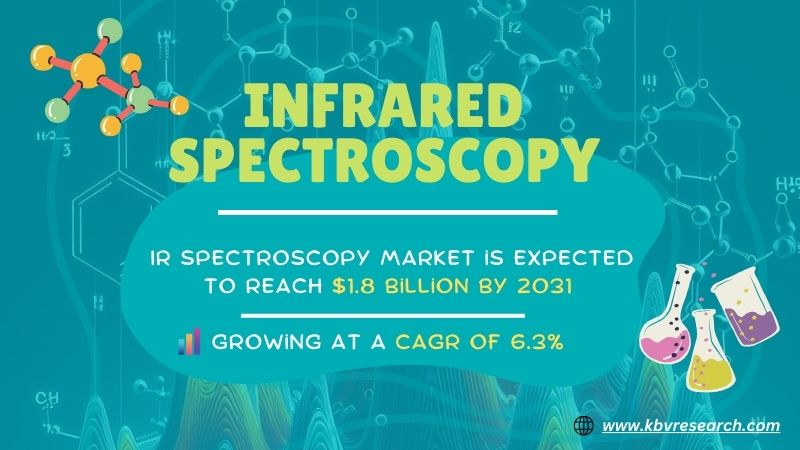
Infrared spectroscopy operates akin to a covert agent, unveiling the concealed identities of chemical compounds. Picture it as a molecular detective, discerning the distinct fingerprints of molecules through their unique vibrational patterns. It's analogous to a forensic investigator scrutinizing fingerprints at a crime scene, albeit, in this case, analyzing molecular vibrations instead of physical prints.
Scientists from various industries use infrared spectroscopy, a potent analytical technique, to identify and examine chemical compounds. It works on the principle that molecules absorb infrared radiation at specific frequencies, leading to characteristic vibrational modes. These unique absorption patterns serve as signatures that help identify the functional groups present in a compound.
In simpler terms, think of it as music. Just as each musical instrument produces a distinct sound, different chemical bonds vibrate at specific frequencies, creating unique "notes" that IR spectroscopy can detect.
Imagine infrared light as a detective's flashlight probing the hidden corners of a molecular landscape. When this light interacts with a sample, certain wavelengths are absorbed while others pass through. The absorbed wavelengths correspond to specific vibrational modes of the chemical bonds within the molecule.
This absorption pattern creates a unique spectrum, much like a barcode, which can be analyzed to identify functional groups, elucidate molecular structures, and even quantify the concentration of compounds present.
Let's delve deeper into how IR spectroscopy deciphers the molecular language—picture molecules as intricate puzzles, with each functional group representing a piece. IR spectroscopy acts as the solver, piecing together the puzzle by detecting the vibrations of these functional groups.
For instance, when infrared radiation passes through a sample, certain frequencies get absorbed based on the bonds' strengths and types in the molecule. By analyzing which frequencies are absorbed and how intensely, scientists can pinpoint the functional groups present, such as carbonyl, hydroxyl, or amino groups.
In essence, IR spectroscopy acts as a molecular fingerprint scanner, identifying compounds' unique chemical makeup with precision.
Now, let's shift our focus to the broader landscape of the Global IR Spectroscopy Market. Several factors are responsible for this market's predicted $1.8 billion growth by 2031.
In the realm of regional dominance, North America emerges as a frontrunner, reigning supreme in the Global IR Spectroscopy Market. With a market value projected to reach $665.7 million by 2031, North America maintains its stronghold through technological innovation and robust industrial infrastructure.
On the other hand, Europe sets its sights on steady growth, poised to exhibit a commendable CAGR of 6% during the forecast period. Meanwhile, the Asia Pacific region shines brightly, experiencing a remarkable CAGR of 7.1%, fueled by burgeoning industrialization and a burgeoning focus on research and development.
In the dynamic landscape of IR spectroscopy, several key players lead the charge towards innovation and excellence. These industry stalwarts include:
Shimadzu leads analytical instruments in IR spectroscopy. With a century of invention, Shimadzu advances science. Their IR spectrometers are used in labs worldwide due to their precision, durability, and ease of use.
Carl Zeiss AG, an optics giant, excels in IR spectroscopy. With decades of optical knowledge, its cutting-edge IR spectrometers perform unparalleledly. Thanks to their quality and creativity, researchers and analysts use cutting-edge analytical tools.
Revvit, Inc. revolutionizes IR spectroscopy with its revolutionary solutions. Revvit's portable and handheld IR spectrometers make on-site observations easy, democratizing spectroscopic analysis. Their small yet powerful gadgets, from pharmaceutical manufacturing to environmental monitoring, are redefining field applications.
Agilent Technologies, Inc., a leader in analytical instrumentation, improves IR spectroscopy. Agilent constantly innovates IR spectrometers with sensitivity, speed, and spectral resolution. Their diverse devices support fundamental research and industrial quality control.
Bruker Corporation makes world-class analytical instruments, including IR spectroscopy. Bruker innovates and delights customers with high-performance, flexible IR spectrometers. With high-throughput screening and forensic analysis, Bruker helps scientists advance pharmaceutical research and criminal investigations.
Global tech giant ABB Group excels in IR spectroscopy. ABB researches and develops advanced spectroscopic methods to increase industry productivity. Their IR spectroscopy, automation, and data analytics solutions boost global corporate processes and decision-making.
In conclusion, infrared spectroscopy serves as a window into the molecular world, providing invaluable insights into the composition and structure of compounds. Thanks to technological advancements and expanding applications, the global IR spectroscopy market is growing rapidly, offering exciting opportunities for businesses and researchers.
So, whether you're a chemist unravelling the mysteries of organic compounds or a quality control expert ensuring product safety, IR spectroscopy is your trusted ally in the quest for knowledge and discovery.
Armed with the knowledge of IR spectroscopy's capabilities and market dynamics, let's embark on a journey of exploration and innovation in the fascinating realm of molecular analysis.